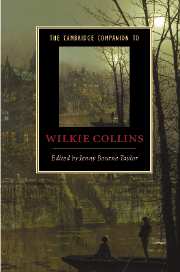Book contents
- Frontmatter
- Introduction
- 1 Collins’s career and the visual arts
- 2 The early writing
- 3 Collins’s shorter fiction
- 4 Collins and the sensation novel
- 5 The Moonstone, detective fiction and forensic science
- 6 The later novels
- 7 The professional writer and the literary marketplace
- 8 The marriage plot and its alternatives
- 9 Collins and Victorian masculinity
- 10 Collins and empire
- 11 Disability and difference
- 12 Collins and the theatre
- 13 The afterlife of Wilkie Collins
- Further reading
- Index
- Series List
6 - The later novels
Published online by Cambridge University Press: 28 January 2007
- Frontmatter
- Introduction
- 1 Collins’s career and the visual arts
- 2 The early writing
- 3 Collins’s shorter fiction
- 4 Collins and the sensation novel
- 5 The Moonstone, detective fiction and forensic science
- 6 The later novels
- 7 The professional writer and the literary marketplace
- 8 The marriage plot and its alternatives
- 9 Collins and Victorian masculinity
- 10 Collins and empire
- 11 Disability and difference
- 12 Collins and the theatre
- 13 The afterlife of Wilkie Collins
- Further reading
- Index
- Series List
Summary
What brought good Wilkie’s genius nigh perdition?
Some demon whispered – ‘Wilkie! Have a mission.’
At the beginning of November 1889, just over a month after Wilkie Collins's death, a lengthy retrospect by Algernon Swinburne appeared in the Fortnightly Review. Surveying the long sweep of Collins's career, Swinburne praised the novelist's narrative flair: 'far beyond the reach of any contemporary, however far above him in the loftier and clearer qualities of genius' (CH, p. 254). However, 'there are many', he went on, 'who think that Wilkie Collins would have a likelier chance of a longer life in the memories of more future readers if he had left nothing behind him but his masterpiece The Moonstone and one or two other stories' (CH, p. 259). Although much of the later fiction had real merit, Swinburne concluded, and 'nothing can be more fatuous than to brand all didactic or missionary fiction as an illegitimate or inferior form of art' (CH, p. 262), Collins's tendency to engage explicitly with social issues after 1870 could often be heavy-handed.
Swinburne's parody of Alexander Pope stuck stubbornly to Collins's later writing through most of the twentieth century: the last two decades of his life are generally regarded as a long-drawn-out creative twilight, punctuated by 'fitful gleams' (Peters, p. 313). The loss of the steadying hand of Charles Dickens in 1870 has been one explanation of this decline, alongside the continuing influence of Charles Reade, whose minutely researched polemical novels and plays addressed topical issues such as prison reform. Collins's failing health, his growing dependence on laudanum and a host of other medications to relieve the agonising pain of ocular gout and rheumatic illness, together with the demands of two families and his theatrical activities have added to this picture, as literary influence, bodily and mental fragility, a complicated personal and professional life, and a more explicit ideological stance have blended into an overarching narrative that has dominated readings of his later work.
- Type
- Chapter
- Information
- The Cambridge Companion to Wilkie Collins , pp. 79 - 96Publisher: Cambridge University PressPrint publication year: 2006
- 3
- Cited by

